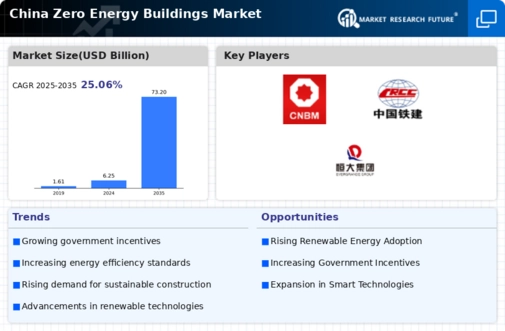Rising Energy Costs
In recent years, energy prices in China have shown a notable upward trend, which has heightened the focus on energy efficiency in the construction sector. As energy costs continue to rise, the financial viability of zero energy buildings becomes more appealing to both developers and consumers. The zero energy-buildings market stands to benefit from this shift, as these structures are designed to minimize energy consumption and maximize renewable energy generation. With energy prices projected to increase by approximately 15% over the next five years, the economic rationale for investing in zero energy buildings strengthens. This trend suggests that more stakeholders may consider zero energy buildings as a cost-effective solution, thereby propelling the market forward.
Regulatory Framework Enhancements
The regulatory landscape in China is evolving to support the zero energy-buildings market. Recent policies have mandated stricter energy efficiency standards for new constructions, which could lead to a surge in demand for zero energy buildings. The government aims to reduce energy consumption by 20% by 2030, which aligns with the objectives of the zero energy-buildings market. Furthermore, local governments are increasingly adopting building codes that promote sustainable practices, thereby incentivizing developers to invest in energy-efficient technologies. This regulatory push not only fosters innovation but also creates a competitive environment for construction firms, potentially increasing the market size significantly. As a result, the zero energy-buildings market is likely to experience robust growth driven by these regulatory enhancements.
Urbanization and Population Growth
China's rapid urbanization and population growth are significant drivers for the zero energy-buildings market. As urban areas expand, the demand for housing and commercial spaces increases, leading to a pressing need for sustainable construction solutions. The urban population is expected to reach 1 billion by 2030, which necessitates innovative building designs that can accommodate this growth while minimizing environmental impact. Zero energy buildings, with their focus on energy efficiency and renewable energy integration, present a viable solution to meet these demands. Consequently, the zero energy-buildings market is likely to see increased investment and development activity as urban planners and developers seek to create sustainable living environments.
Increased Investment in Renewable Energy
Investment in renewable energy sources is a critical driver for the zero energy-buildings market in China. The government has set ambitious targets for renewable energy generation, aiming for 20% of total energy consumption to come from renewable sources by 2030. This commitment is likely to spur the development of zero energy buildings, which rely on renewable energy systems such as solar panels and wind turbines. As financial resources are allocated to support renewable energy projects, the zero energy-buildings market may experience a surge in growth. The synergy between renewable energy investments and zero energy building initiatives suggests a robust market trajectory, as stakeholders recognize the long-term benefits of sustainable energy solutions.
Technological Integration in Construction
The integration of advanced technologies in construction processes is transforming the zero energy-buildings market in China. These advancements are crucial for achieving zero energy status. Innovations such as Building Information Modeling (BIM), smart grid technology, and energy management systems are enhancing the design and operational efficiency of zero energy buildings. These technologies facilitate better energy monitoring and management, which is crucial for achieving zero energy status. As construction firms increasingly adopt these technologies, the market is expected to expand, driven by improved project outcomes and reduced operational costs. The potential for technological advancements to streamline construction processes and enhance building performance indicates a promising future for the zero energy-buildings market.

















Leave a Comment